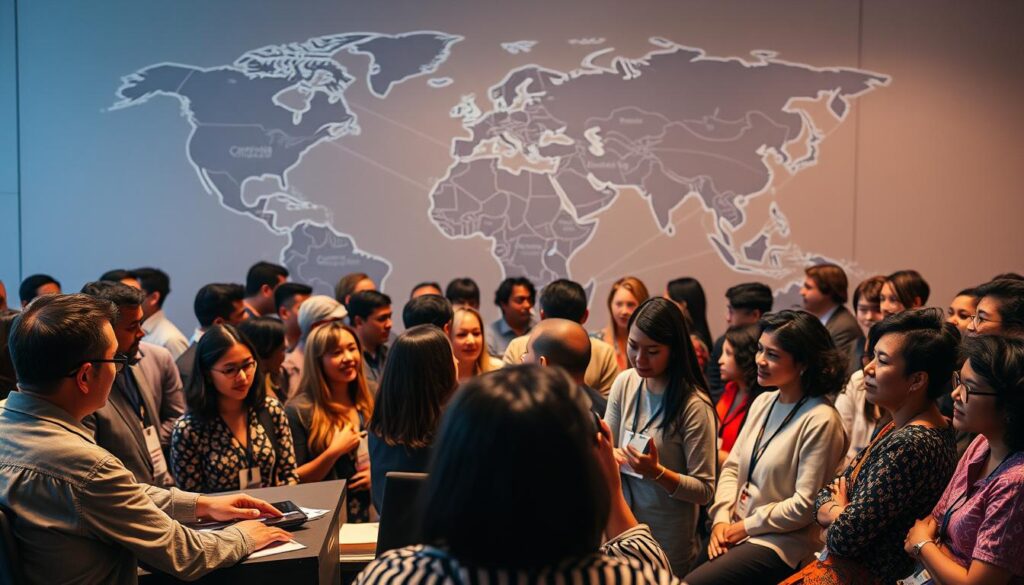Ever thought about how online choices are shaped by secret algorithms? These systems might unfairly favor some over others. Algorithmic bias is a big deal in the world of machine learning and artificial intelligence.
As tech takes over our lives, knowing about this issue is key. It affects everything from job searches to medical care. In Southeast Asia, where AI is growing fast, tackling algorithmic bias is a must for fair technology.
We’ll look into why algorithmic bias happens and how it affects us. We’ll also talk about ways to fight it. This will help make AI that’s good for everyone.
Key Takeaways
- Algorithmic bias leads to systematic errors in algorithmic outputs.
- It can significantly affect sectors like healthcare, hiring, and justice.
- Addressing this bias is crucial to ensure fairness in technology.
- Legal frameworks, such as the EU AI Act, aim to regulate algorithmic bias.
- Diverse data sets and continuous monitoring can mitigate algorithmic bias.
Understanding Algorithmic Bias
Algorithmic bias means algorithms make mistakes that hurt certain groups more. This is big in data science because algorithms are used in many areas, like hiring and law enforcement. Knowing how these biases start helps us fix them for society’s good.
Definition of Algorithmic Bias
Algorithmic bias happens when AI models are trained on data that doesn’t really show what the world is like. This often comes from biases in training data, making the data skewed. For example, facial recognition systems that mostly use images of light-skinned people will often get it wrong for darker skin tones.
This mistake can lead to wrong arrests or bad services for groups that are already treated unfairly. It shows we really need to find and fix these biases.
How Does Algorithmic Bias Occur?
There are a few reasons why algorithmic bias happens:
- Historical Data Influence: Algorithms use old data that shows unfairness, making things worse.
- Human Programming Decisions: The choices people make when designing algorithms can also introduce bias. For example, Amazon’s hiring tool favored men because there were fewer women in tech jobs.
- Evaluation Misinterpretations: Sometimes, we think algorithms are fair when they’re not. This makes it hard to spot biases.
In data science, we need to watch out for biases to stop them from getting worse. As leaders understand the need for responsible AI, keeping an eye on biases is key. Companies should use diverse data and be open about how they work to make sure their algorithms are fair.
The Impact of Algorithmic Bias on Society
Algorithmic bias has a big impact on our society. It makes discrimination and inequality worse. Algorithms that reflect our biases can unfairly treat certain groups, like minorities.
This unfair treatment is seen in important areas like healthcare, finance, and education. It can lead to serious problems, making people worry about legal and financial issues for companies using these technologies.
Discrimination and Inequality
Biased algorithms can discriminate against certain groups. This happens when they’re trained on data that already shows bias. This data often comes from a time when there were more inequalities.
In healthcare, algorithms might not give some groups the treatments they need. In education, they might not suggest the right courses for students from low-income families. This makes inequality even worse.
Legal and Financial Risks
Companies that use biased algorithms could face big legal problems. Not following anti-discrimination laws can cost a lot of money. It can also hurt a company’s reputation.
In the Philippines, using biased AI can lose the trust of people. This shows how important it is for companies to make sure their algorithms are fair.
Root Causes of Algorithmic Bias
Algorithmic bias is a big problem in data science and tech. It’s important to know why it happens to make systems fair and effective. Biases in training data and flaws in algorithm design are the main reasons. Understanding how these issues work together can help fix biased algorithms.
Biases in Training Data
Biases in training data are key to algorithmic bias. If the data used for training has historical biases, the algorithm’s results will show these biases. For example, biased data can unfairly favor some racial or gender groups, leading to discrimination.
Also, if the data doesn’t include everyone, it can lead to unfairness in things like hiring. This is because it misses out on the experiences of underrepresented groups.
Algorithm Design Flaws
How algorithms are designed also plays a big role in bias. Developers might unknowingly add their own biases into the algorithms. This can happen when they use data that doesn’t really show what they want to measure.
This creates a cycle where biased results just make the problem worse. To fix this, we need to make algorithm design more open and work to remove these biases.
Examples of Algorithmic Bias
Algorithmic bias is a big problem in many areas. It affects people and communities a lot. We’ll look at where bias is most common.
Bias in Healthcare Decisions
In healthcare, algorithms can make big decisions. But, they often have biases. For example, some systems don’t help women and minorities as much.
This can lead to wrong diagnoses and bad health care. The National Institute of Standards and Technology says AI often ignores these problems. This makes health care unfair for some groups.
Bias in Recruitment Processes
Recruitment also has biases. Amazon’s hiring tool was criticized for liking male candidates more. It was based on data from mostly white males.
Another study found job ads for high-paying jobs were shown to men more than women. This makes it hard for women to get good jobs. For more on this, check out related studies.
Explore studies on biases in recruitment.
Bias in Criminal Justice Systems
The criminal justice system also has biases. Tools like COMPAS give higher-risk scores to African-Americans. This means they get detained longer.
This bias keeps unfairness going. It makes people doubt justice. We need to fix these systems to fight old injustices.

The Role of Machine Learning and Artificial Intelligence
Machine learning and artificial intelligence play big roles in many areas. They help make data-driven decisions better. But, when these technologies use biased data, they can spread inequality.
In data science, how algorithms are made and trained is key. Old biases can sneak into these systems. This affects decisions in healthcare, finance, and jobs. For example, racial disparities in mortgage approvals show a big problem.
Black applicants were 80% more likely to be rejected than whites. This shows how important it is to manage data well.
Artificial intelligence can bring new ideas but also keep old problems alive. A hiring algorithm at Amazon favored men, leading to a big change. This shows we need to make AI fair and open.
For businesses in Southeast Asia, using ethical AI is crucial. It helps build trust with customers. By tackling bias, companies can lead in fair data science. They must keep checking their AI systems to fix any problems.
Consequences of Ignoring Algorithmic Bias
Ignoring algorithmic bias can harm businesses a lot. It can lead to legal problems and a drop in consumer trust. Companies that ignore these biases might face lawsuits for breaking anti-discrimination laws.
But it’s not just about the law. Businesses linked to biased AI systems can lose a lot of trust from customers. This is very important in fast-changing markets like Southeast Asia. There, people want fairness and clearness from brands.
Legal Repercussions for Businesses
Legal troubles from algorithmic bias can come in many forms. Companies might get sued, fined, or have to do audits. Discrimination in hiring, which hurts women and minorities, can lead to unfair pay and fewer jobs.
This can cause big legal problems for companies in strict places.
Loss of Consumer Trust
When companies ignore algorithmic bias, they lose consumer trust. People like to support brands that are fair and ethical. In today’s world, finding out about bias can hurt a company’s image fast.
To keep trust, businesses must be open and fair. They must avoid the mistakes of biased AI that can lose people’s confidence.

Strategies for Mitigating Algorithmic Bias
To fight algorithmic bias, companies need to use several strategies. These methods make AI systems fairer and more trustworthy. They help diverse groups by using diverse data and constant checks.
Diverse and Representative Data Sets
Using diverse data is key to beating algorithmic bias. Data that shows the variety of people’s ages, genders, races, and backgrounds helps. This way, companies can avoid old biases.
They can also clean and protect this data. Using special algorithms during training makes AI outputs fairer. Working with different teams helps spot biases early on.
Continuous Monitoring and Auditing
Keeping an eye on AI systems is crucial. Companies should check these systems often to find new biases. They can use fairness metrics in audits to catch biases quickly.
Being open about data and algorithms builds trust. It lets people check the AI’s work. Having humans review AI decisions makes the system more accountable.
Ethical AI and Inclusive Technology
The path to ethical AI is about making sure every AI decision is fair and clear. This is key for developers and users from all walks of life. It helps us see and fix the unfairness in AI’s choices.
Ignoring these biases can lead to unfair treatment of some groups. By focusing on fairness, we make AI work for everyone, not just some.
Importance of Fairness in Algorithms
Fairness is crucial for ethical AI. We must check algorithms for biases in their training data. For example, facial recognition systems often struggle with darker skin tones.
By aiming for fairness, companies can make AI that works for everyone. This leads to better results and more trust in these technologies.
Diversity in Tech Development
Diversity in tech is a big plus. A team with different views can spot and fix algorithm flaws. It helps understand users better and their challenges.
Companies that want inclusive tech should hire people from all backgrounds. This not only spots biases better but also brings new ideas to the table.

| Factor | Impact | Examples |
|---|---|---|
| Fairness in Algorithms | Prevents discrimination | Hiring tools with equal opportunity for all |
| Diversity in Tech | Enhances innovation | AI solutions that cater to various demographics |
| Inclusive Technology | Improves user trust | Accessible AI for different abilities and backgrounds |
Governance Frameworks for Addressing Algorithmic Bias
Creating effective governance frameworks is key to tackling algorithmic bias in healthcare and tech. These frameworks need to follow ethical AI development rules. They should focus on being open, diverse, and accountable.
A study by the Agency for Healthcare Research and Quality and the National Institute on Minority Health and Health Disparities found five key principles. These principles help address algorithmic bias in healthcare. They aim to ensure health equity at every stage of an algorithm’s life cycle.
- Promote health equity at all phases of the algorithm life cycle.
- Ensure algorithms are explainable and transparent.
- Engage patients and communities in the model’s development and application.
- Identify fairness issues and trade-offs associated with algorithm use.
- Establish accountability for fairness and equity in algorithm outcomes.
Healthcare algorithms often unfairly affect marginalized groups and those from lower-income backgrounds. Using transparent AI governance can help reduce these biases. It also builds trust in diverse communities.
To implement visionary AI governance, clear policies and regulations are needed. This includes regular audits and impact assessments. Oversight committees help address biases in AI systems.
Involving diverse stakeholders is crucial for understanding AI biases. Ethicists, sociologists, legal experts, and community members can drive reforms. Transparency reports are also key for accountability, showing how AI systems perform and what data they use.
Comprehensive AI governance offers solutions for responsible AI use. It emphasizes independent audits and thorough risk assessments. These efforts aim to improve AI governance continuously, tackling new challenges and integrating valuable insights into AI design and use.
Global Efforts to Combat Algorithmic Bias
Many global efforts are underway to tackle algorithmic bias. The EU AI Act is a key example. It sets strict rules for high-risk AI systems. This law makes companies responsible for bias and discrimination, showing the need for responsible AI.
EU AI Act and Other Regulations
The EU AI Act is a big step in AI rules. It has rules to reduce bias in automated systems. Countries in Europe are making their policies match these rules.
This shows how important it is to define AI risks and benefits. Policymakers are starting to see AI’s value and its challenges.
Case Studies from Asia
Asia has shown success in fighting algorithmic bias. Singapore is leading with proactive frameworks. These frameworks help follow rules and show teamwork between government and tech.
These efforts are part of a bigger trend in Asia. The region is having deep talks about AI. They want to make sure AI is used ethically in many areas.

Conclusion
Algorithmic bias is a big problem in today’s fast-changing tech world. It affects more than just apps, impacting society as a whole. As companies use more AI and machine learning, fixing these biases is more urgent than ever.
For example, Black males often get longer sentences than White ones because of biased data. In healthcare, algorithms sometimes give the wrong resources because of bad data. These examples show we really need to focus on making AI fair and reducing bias.
Making technology more inclusive is key to fighting discrimination. It also helps companies be seen as leaders in using tech responsibly. By using diverse data and keeping a close eye on how tech works, we can fight biases in many areas.
In Southeast Asia, businesses that focus on ethical AI avoid legal trouble and gain customer trust. This leads to a fairer digital world for everyone.
It’s important for everyone to talk about algorithmic bias more. We need to push for clear and fair tech use. By working together, we can make sure technology helps everyone equally.

